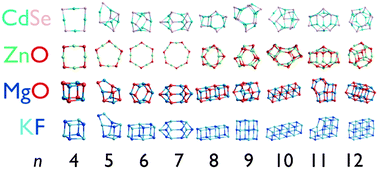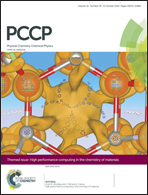Structure prediction of nanoclusters; a direct or a pre-screened search on the DFT energy landscape?
Abstract
The atomic structure of inorganic nanoclusters obtained via a search for low lying minima on energy landscapes, or hypersurfaces, is reported for inorganic binary compounds: zinc oxide (ZnO)n, magnesium oxide (MgO)n, cadmium selenide (CdSe)n, and potassium fluoride (KF)n, where n = 1–12 formula units. The computational cost of each search is dominated by the effort to evaluate each sample point on the energy landscape and the number of required sample points. The effect of changing the balance between these two factors on the success of the search is investigated. The choice of sample points will also affect the number of required data points and therefore the efficiency of the search. Monte Carlo based global optimisation routines (evolutionary and stochastic quenching algorithms) within a new software package, viz. Knowledge Led Master Code (KLMC), are employed to search both directly and after pre-screening on the DFT energy landscape. Pre-screening includes structural relaxation to minimise a cheaper energy function – based on interatomic potentials – and is found to improve significantly the search efficiency, and typically reduces the number of DFT calculations required to locate the local minima by more than an order of magnitude. Although the choice of functional form is important, the approach is robust to small changes to the interatomic potential parameters. The computational cost of initial DFT calculations of each structure is reduced by employing Gaussian smearing to the electronic energy levels. Larger (KF)n nanoclusters are predicted to form cuboid cuts from the rock-salt phase, but also share many structural motifs with (MgO)n for smaller clusters. The transition from 2D rings to 3D (bubble, or fullerene-like) structures occur at a larger cluster size for (ZnO)n and (CdSe)n. Differences between the HOMO and LUMO energies, for all the compounds apart from KF, are in the visible region of the optical spectrum (2–3 eV); KF lies deep in the UV region at 5 eV and shows little variation. Extrapolating the electron affinities found for the clusters with respect to size results in the qualitatively correct work functions for the respective bulk materials.

- This article is part of the themed collection: High performance computing in the chemistry of materials

 Please wait while we load your content...
Please wait while we load your content...